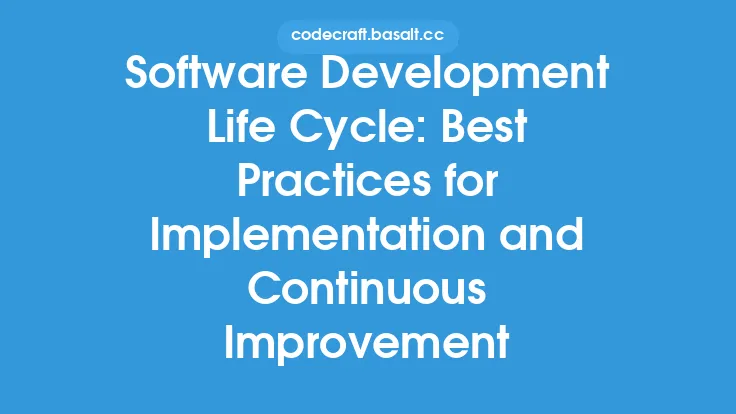In today's fast-paced software development landscape, the ability to quickly deliver high-quality products to market is crucial for staying competitive. One key strategy for achieving this goal is by leveraging continuous integration and deployment (CI/CD). CI/CD is a set of practices that enables development teams to deliver software changes more frequently and reliably, reducing the time it takes to get new features and updates to customers. By automating the build, test, and deployment process, teams can improve the speed and quality of their software releases, ultimately leading to faster time-to-market.
Introduction to Continuous Integration and Deployment
Continuous integration (CI) and continuous deployment (CD) are two closely related practices that work together to enable faster and more reliable software delivery. Continuous integration involves automatically building and testing code changes as they are committed to a version control system, ensuring that the codebase remains stable and functional. Continuous deployment takes this a step further by automatically deploying code changes to production after they have passed through the CI pipeline. This approach allows teams to deliver software changes quickly and reliably, without the need for manual intervention.
Key Components of a CI/CD Pipeline
A CI/CD pipeline typically consists of several key components, including source code management, build automation, automated testing, and deployment automation. Source code management tools, such as Git, are used to manage changes to the codebase and trigger the CI/CD pipeline. Build automation tools, such as Jenkins or Travis CI, are used to automate the build and testing process, ensuring that the code is compiled and tested correctly. Automated testing tools, such as Selenium or Appium, are used to verify that the code changes do not introduce new bugs or errors. Finally, deployment automation tools, such as Ansible or Kubernetes, are used to automate the deployment of code changes to production.
Benefits of CI/CD for Faster Time-to-Market
The benefits of CI/CD for faster time-to-market are numerous. By automating the build, test, and deployment process, teams can reduce the time it takes to get new features and updates to customers. This is because CI/CD pipelines can run automatically, without the need for manual intervention, allowing teams to deliver software changes quickly and reliably. Additionally, CI/CD pipelines can help teams to identify and fix errors earlier in the development process, reducing the likelihood of downstream problems and improving overall software quality. This, in turn, can lead to increased customer satisfaction and loyalty, as well as a competitive advantage in the market.
Technical Considerations for Implementing CI/CD
Implementing a CI/CD pipeline requires careful consideration of several technical factors, including infrastructure, tooling, and process. Teams must have a solid understanding of their infrastructure and tooling requirements, including the need for scalable and reliable servers, storage, and networking. They must also select the right tools for their CI/CD pipeline, including source code management, build automation, automated testing, and deployment automation tools. Finally, teams must define a clear and efficient process for their CI/CD pipeline, including the sequence of events, the criteria for passing or failing builds, and the handling of errors and exceptions.
Best Practices for CI/CD Pipeline Management
To get the most out of a CI/CD pipeline, teams should follow several best practices for pipeline management. These include monitoring and logging pipeline activity, to ensure that issues are identified and addressed quickly. Teams should also implement automated testing and validation, to ensure that code changes are thoroughly tested and validated before deployment. Additionally, teams should use continuous monitoring and feedback to identify areas for improvement and optimize the pipeline for better performance. Finally, teams should establish clear and consistent processes for managing pipeline changes, including code reviews, testing, and deployment.
Overcoming Common Challenges in CI/CD Implementation
Despite the many benefits of CI/CD, implementation can be challenging, and teams may encounter several common obstacles. These include cultural and organizational barriers, such as resistance to change or lack of buy-in from stakeholders. Teams may also encounter technical challenges, such as integrating multiple tools and systems, or ensuring consistent and reliable pipeline performance. To overcome these challenges, teams should focus on building a strong culture of collaboration and continuous improvement, and should invest in the necessary tools and training to support their CI/CD pipeline. Additionally, teams should be patient and persistent, recognizing that CI/CD implementation is a journey that requires time, effort, and dedication.
Conclusion and Future Directions
In conclusion, leveraging continuous integration and deployment is a key strategy for achieving faster time-to-market in software development. By automating the build, test, and deployment process, teams can improve the speed and quality of their software releases, ultimately leading to increased customer satisfaction and loyalty. As the software development landscape continues to evolve, it is likely that CI/CD will play an increasingly important role in enabling teams to deliver high-quality software quickly and reliably. By following best practices for CI/CD pipeline management, overcoming common challenges, and staying up-to-date with the latest tools and technologies, teams can unlock the full potential of CI/CD and achieve faster time-to-market.





